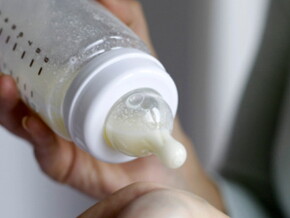
The mother-infant connection established when feeding a baby (whether breast or bottle) not only helps to build a bond, but it also contributes to baby’s cognitive and emotional development.[1] Feeding also ensures that baby gets the energy and nutrients they need.
Each portion of the digestive tract plays a role in your baby’s health and growth. Throughout the digestive process, baby absorbs small, protective proteins in breast milk (called antibodies) which fight against harmful bacteria and viruses, as well as establish healthy gut bacteria.
But what role does each portion play, and how are they important to baby’s wellbeing and growth? To start, let’s look at the steps the food takes as it travels through baby’s digestive tract.
The journey of baby’s first food
In baby’s first six months, experts recommend exclusive breastfeeding to ensure optimal nutrition, immune protection, growth and development of infants. In addition to important nutrients like protein, vitamins, and zinc, breast milk naturally contains antibodies and good bacteria which contribute to the development of a healthy digestive tract flora and stronger immune system.
Like in adults, a baby’s digestive system – or gastrointestinal tract – is complicated. The description below outlines the significant role each part plays in digestion:
- Mouth – not only where baby accepts food, but it’s also where digestion begins! Salivary glands release enzymes here to begin digestion.
- Esophagus – the tube which pushes fluid from the mouth to the stomach and stops reflux/backflow. There is a valve at the bottom of the tube controlling entry to the stomach, which is underdeveloped in babies, explaining why they often spit up.
- Stomach – stores, combines and disintegrates food and releases it to the small intestine. Stomach acid also kills bad bacteria here.
- Small intestine – where digestive enzymes from the liver and pancreas break down partially-digested food from the stomach to help break food into fats, proteins, and carbohydrates. Nutrients and vitamins are absorbed into the bloodstream.
- Large intestine (colon) – food that is not absorbed in the small intestine passes here, where water and electrolytes are absorbed into the blood.
- Rectum – a holding area for waste products from the digestive process, which are later excreted.
Importance of baby’s digestive tract
Baby’s digestion is not only important for proper nutrient absorption, but it is also directly linked to the health of our immune system. Did you know that up to 80% of the body’s immune cells are found in the digestive tract?[2] The digestive tract also contains over 500 kinds of bacteria,[3] many of which contribute to the health of our immune system. Breast milk contains good bacteria called probiotics, which support the development of healthy gut flora and a strong immune system.[4] Learn more about the sources of probiotics for your baby now.
New parents are extremely aware of their baby’s digestive processes, as hunger, thirst, and bowel movements require regular attention. In the first year, the digestive tract is sensitive and underdeveloped, so it’s not uncommon for irregularities such as spit-up, upset stomach, diarrhea, constipation, vomiting, or hiccups to occur.
It’s normal to worry about baby's digestive health. Always follow medical advice and recommendations, and if you think your baby is experiencing serious digestive problems, speak with your doctor.
This article has been sponsored by Nestlé Baby & me, but all comments and opinions are my own.
 Dr. Jeff Habert, MD, CCFP, FCFP
Dr. Jeff Habert, MD, CCFP, FCFP
Dr. Jeff Habert is a Toronto-based family physician with over 28 years of experience. He completed his medical education at the University of Toronto. Dr. Habert is also an Assistant Professor in the Department of Family and Community Medicine at the University of Toronto and a Peer Assessor for the College of Physicians and Surgeons of Ontario.
References:
[1] Sullivan et al. Infant bonding and attachment to the caregiver: Insights from basic and clinical science. Clin Perinatol 2011 Dec; 38(4): 643–655. Retrieved from: https://www.ncbi.nlm.nih.gov/pmc/articles/PMC3223373/ Accessed on April 19, 2018.
[2] Tannock GW. In: Probiotics, other nutritional factors, and intestinal microflora. Nestlé Nutrition Workshop Series 1999;42:17–31.
[3] Brandtzaeg P, et al. Gastroenterol 1989;97:1562–84.
[4] Mohan R, et al. J Pediatr Gastroenterol Nutr 2006;45:E36–7. (abstr)





















